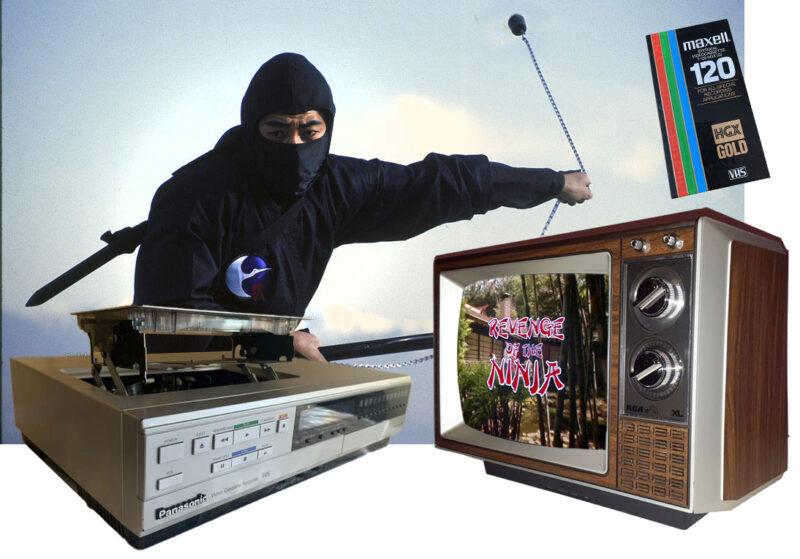
The Moment
Forty years ago… a time when a pay-cable service like HBO would have half-hour monthly trailer shows previewing the new batch of arriving movies. I’m a highly impressionable 14-year old watching a guy catch arrows in his teeth while surrounded by a squad of black-clad swordsmen in red headbands and sashes. A narrator is hyping up the newly arriving Revenge of the Ninja with the usual ad-copy hyperbole, and at this point I’m a blackened cinder, having just been struck by lightning. The trailer show gets repeated a few times a day at the switch over of months and the next time it airs I record it on a VHS tape I’ve been loading with music videos, wrestling matches and random movie fight scenes. In the interminable two-week lag before Revenge actually debuts, I absolutely wear that tape thin, watching and rewinding the 18-20 seconds of footage shown, tattooing it on my brain for all time.
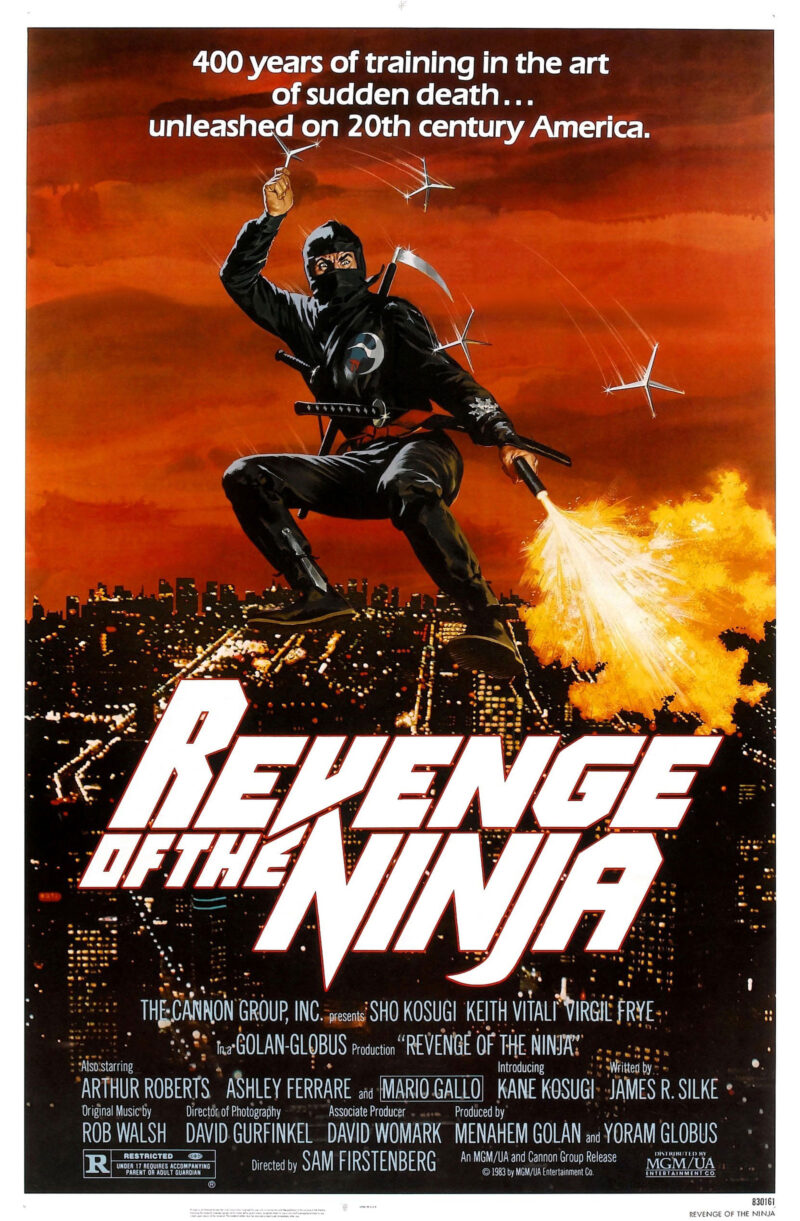
I was already more aware of this new “ninja” thing than most others around me. There were two newsstands inside competing drug stores at either end of the main drag in my tiny Massachusetts cow-and-mill town, and as youngsters without any real income we had made an art of ingesting entire issues of magazines by chaining together minute-long intervals of frantic page flipping before the inevitable ‘You gotta buy that to read it kid” shut us down at one store, only to be picked up at the other — reverse, repeat. The ninja articles in Black Belt and ilk had become frequent, heralds of the later-coined “ninja boom” which was in its early stages. The Octagon, modestly impactful when theatrically released, was growing much longer legs on VHS rental and cable. Our town’s one video store was slow to get the newest stuff, and I recall Enter the Ninja always being out, but they did have the two-hour ‘movie’ cut of the Shogun mini-series and its ninja scenes were frequently revisited. Plus, ninja were being slaughtered in comics by the likes of Shang-Chi and Wolverine for a while. Were in the ascent of THE CRAZE, but the scope and depth of it wasn’t so apparent when you were nose-down in its black-hooded maze.
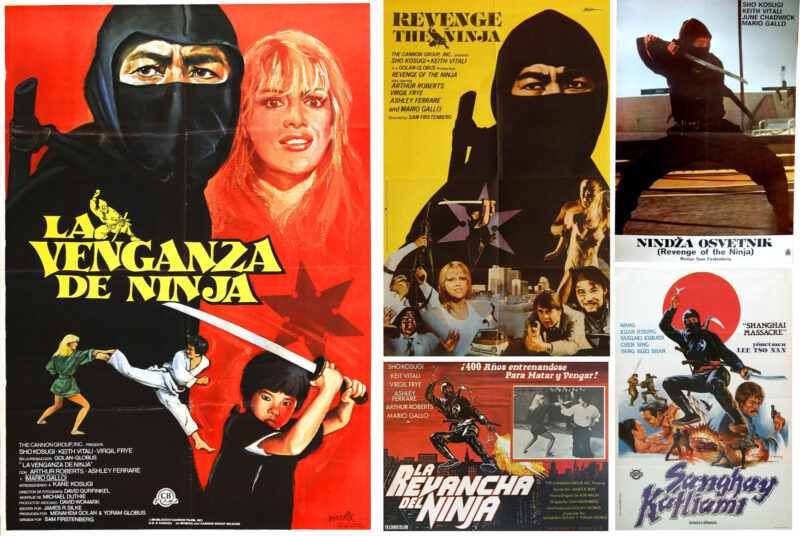
(Various foreign posters — Spain, Pakistan, Mexico, Greece, Poland… and one for another film that took liberties with the ROTN art.)
But then BOOM, there it was — Revenge of the Ninja — all of those building blocks in a finished structure, a shining spire encapsulating all of it. While released in the 1980s, The Octagon and Enter the Ninja were definitely still 1970s in their look, feel, execution and cinematic DNA. But ROTN was EIGHTIES! For those of us coming of age, it was OUR Bruce Lee, OUR new jack martial arts craze — it had 80s action, 80s synth music, 80s neon, girls with ’80s tall butt’ and big 80s hair. It was the full arrival, the full manifestation, of the ninja craze, and it’s still the one movie I’d put in a time capsule to represent the era perfectly.
Of course when it finally did hit cable, I was sitting there, corded remote in-hand, brand new Maxell high grade tape at the ready, and I was even willing to splurge and record it at LP, sacrificing a full movie’s worth of time you’d get in SLP mode, only two films on a tape instead of three. If I recall, I eventually filled the other half of that tape with the rather poor choice of They Call Me Bruce.
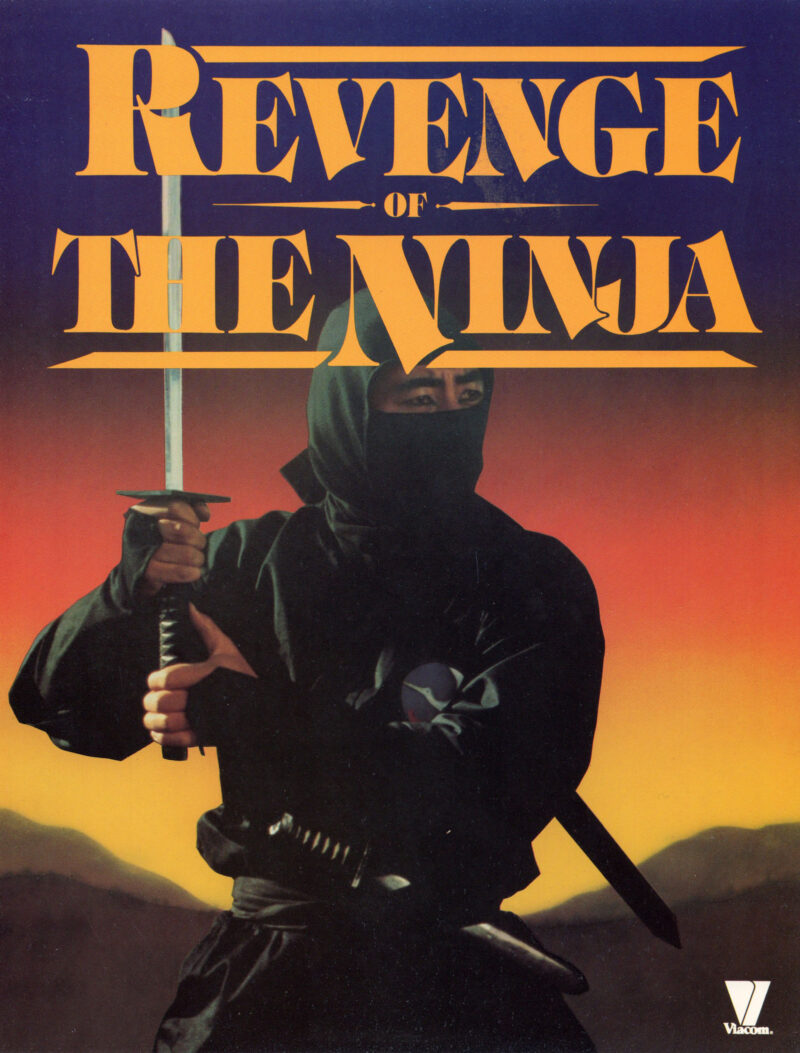
(Viacom’s home video flyer for the film from 1983.)
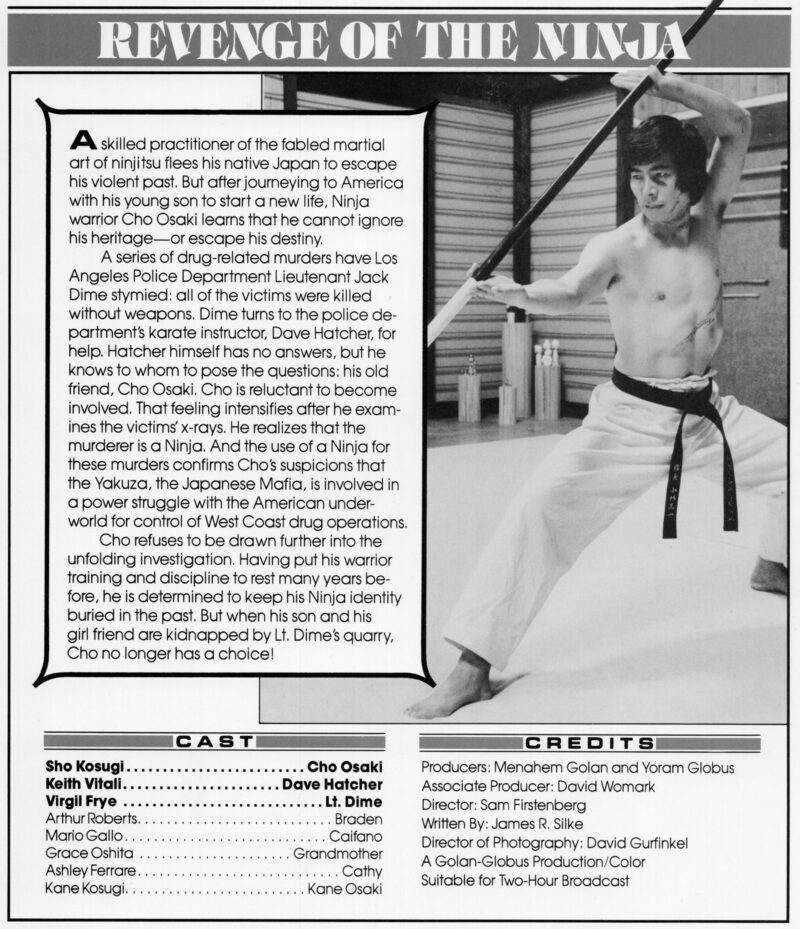
For me and countless others, the arrival of ROTN was the real moment the 80’s ninja craze went into full gear. We now had our avatar film, a summation of everything we wanted in a movie, we now had the creed “Only A Ninja Can Stop a Ninja” and set-in-stone rules of behavior for the genre and character archetype — we had the official sword, how to wear it, the physics of shuriken, the aspirational example of a fog-bellowing light-up chest full of arcane weaponry. Hence, every book, magazine, mail order weapon, action figure, poster, anything… was to make my world more Revenge of the Ninja-like.
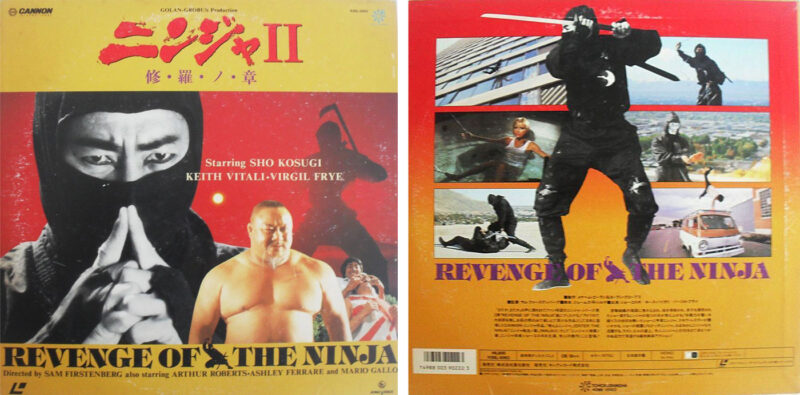
(The Japanese laserdisc for ROTN featured famed pro wrestler and character actor Professor Toru Tanaka much more prominently than any other region’s materials.)
The Miracle that was ROTN
While Enter the Ninja served as a proof-of-concept for the ninja craze, Revenge would be that craze’s first solid example — the flushed-out formula hitting on all cylinders. Enter (and to a way lesser degree The Octagon) proved sound the leap the Western world would make with ninja the Japanese never did — transplanting them with their ancient form intact in a totally modern world. Revenge‘s conceits were essentially built on four sequences in Enter:
- The ninjutsu school (traditional costumed, feudal-era ninja practices still being taught in modern times as an organized art)
- Cole invading the Venarius office tower (ancient garb and weapons defeating modern machine guns and security systems)
- Cole vs. the hired thugs in the sports arena (the concept of one-weapon-one-kill — throw efficiency out the window and instead use as many arcane and exotic props as possible)
- The final ninja-vs-ninja duel laced with formalities (only a ninja can kill another ninja)
These examples would become the tenets of most of the Western-generated ninja fare hence. Another important innovation present in that first Cannon film, and simple as this seems it really sort of came out of nowhere, is making a costumed full-on ninja the good guy. This wasn’t in The Octagon, or Shogun or the episodes of Hawaii 5-0, Kung Fu, Baretta and Quincy that proceeded the 80s boom. [see that evolution here] In those early Hollywood-spawned portrayals (inspired by books like Condor’s Ninja: Clan of Death) shinobi were villains, nameless and faceless cultists serving as threats to the traditional detectives, private dicks and two-fisted Yanks.
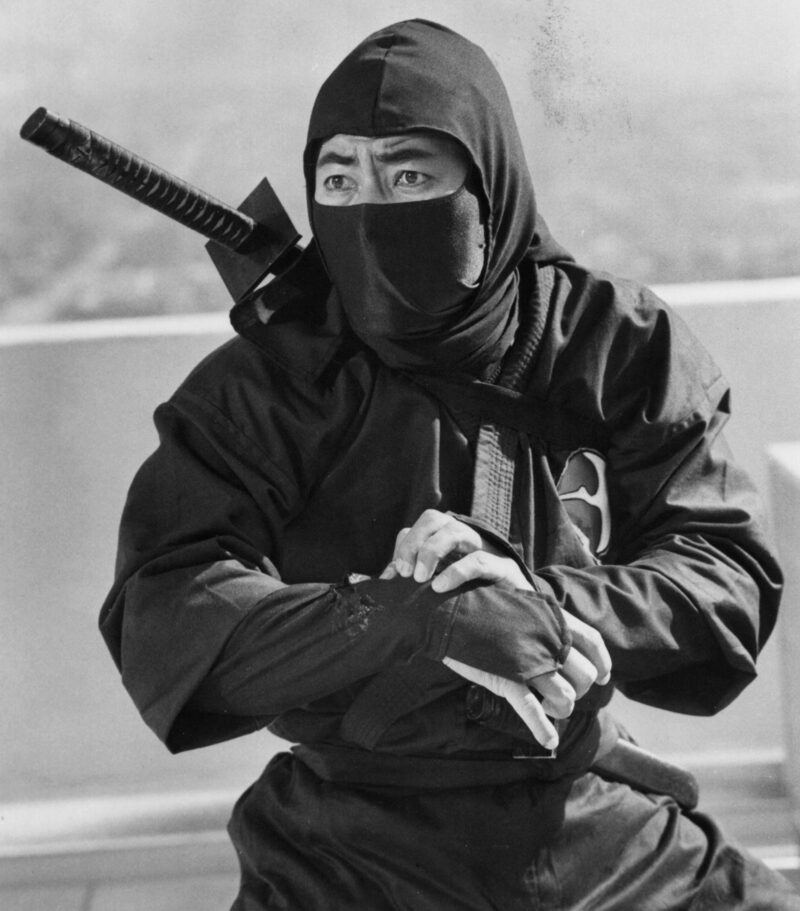
Enter also served as proof-of-concept for the raw star power of Sho Kosugi. That film’s credit sequence is NOT centered on the hero, the dojo demos are NOT the hero, and the most fiery big scale action scene is NOT the hero’s — they were all Hasegawa. It’s no surprise Kosugi became the marketing icon of the film, rather than its supposed big-draw star Franco Nero.
The choices to move onward from ETN with both a hero ninja formula, cast Sho Kosugi as that hero, and to move production to the U.S. where action and stunt work would be noticeably superior were the essential backbone of what was to come.
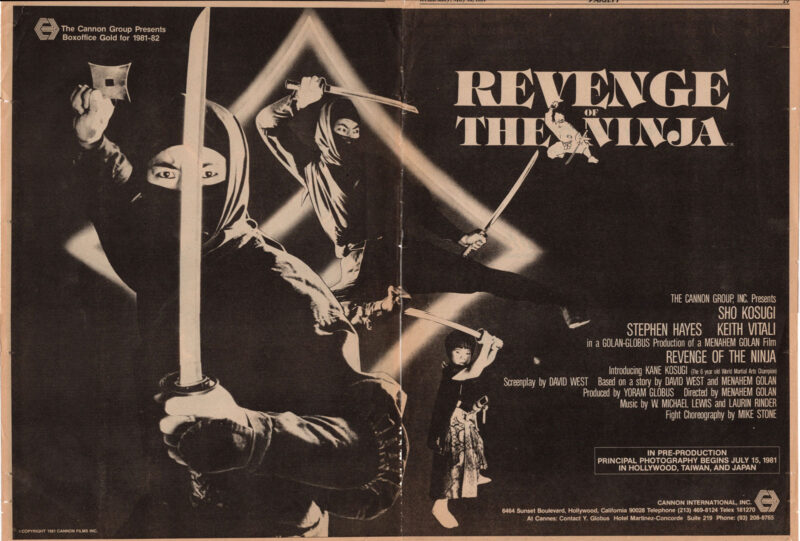
(Cannon’s 2-page spread ad in the May 16th, 1981 issue of Variety heralding pre-production of the sequel to their hit Enter the Ninja. The typography is identical to the first film’s, and save for the shot of Kane so are the images of Kosugi. And just like the earliest boastings of ETN, Stephen Hayes has prominent involvement that would end up not materializing.)
But it wasn’t all formula, some accidental magic went into making ROTN work the way it did, something they truly never captured again. It starts with the hiring of Sam Firstenberg as director. As he admits in numerous interviews, his skill in putting a movie together was proven. His experiences with action however were minimal, and his exposure to martial arts was nil save for some Kurosawa. This would have been fine if like those old TV episodes or The Octagon, ninja were one-dimensional villain fodder to be slaughtered by the run-of-the-mill action star, but ROTN from the get-go was going to be a NINJA MOVIE, ninja to its core. And to execute that, he needed a guardian angel who spoke shinobi…
Now comes Kosugi, with a greatly expanded role on screen and even greater expansion behind the scenes. He is essentially the Mike Stone now, there to fill the voids left by the director, a director who is grateful to have him there for reference and guidance. Sho as ‘ninja guru’ can dip into the realms of fight choreographer, weapons-master, and historical advisor at any given time. On-set ‘advisors’ are sometimes saviors, sometimes pain-in-the-ass traffic cops, often resented and more often only tolerated to a degree that doesn’t ultimately threaten a director’s vision or a producer’s budget. But here, Kosugi is not a rival of the director, but rather the foreman, the trench sergeant, and the only guy who can deliver it all as a one-man-show, and quickly. It ends up being the perfect symbiotic relationship and the results can be seen on screen.
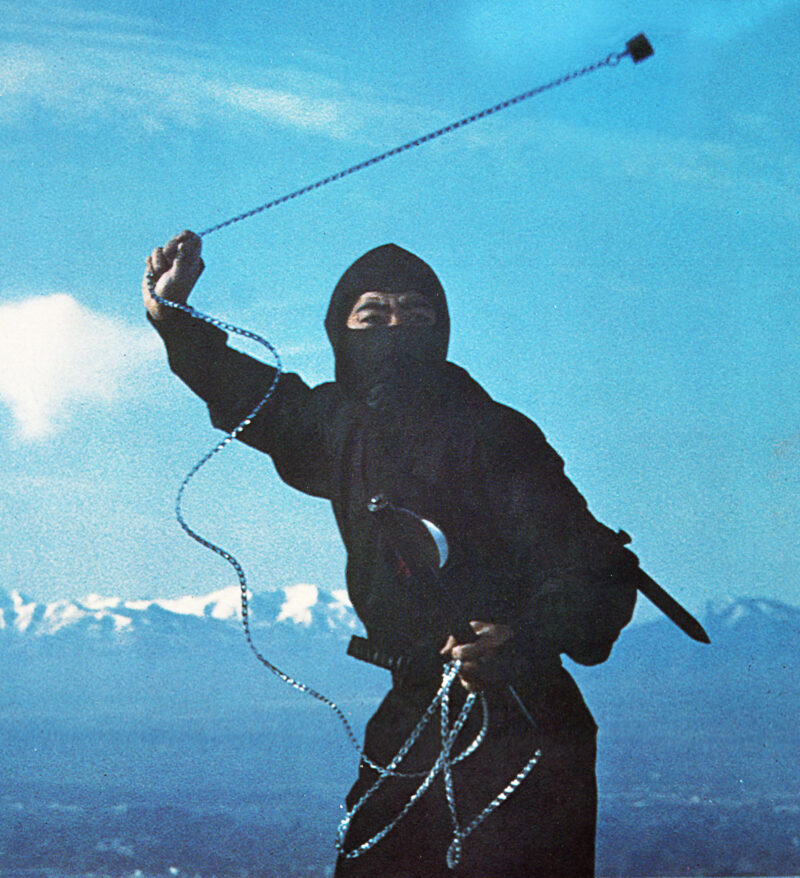
Post Enter, the brilliance of Sho Kosugi’s aggressive ascent is in self-packaging. He takes a knowledge of on-screen ninja he would have absorbed by osmosis as a kid during the 1960’s Japanese ninja boom, and aware of the new interest swelling in the professional martial arts community, serves as a walking Rosetta Stone, translating decades worth of material from the Shinobi no Mono films and Omitsu Kenshin TV series to the published works of Gingetsu Itoh, Fujita Seiko and more recently Masaaki Hatsumi. But he also realizes “martial arts” to Americans mostly means big kicks, and he weaves his championship karate background and demo-team pizazz in a cauldron with black hoods and exotic weapons. You see it clearly in ROTN‘s climactic rooftop duel when in between parrying ninja-to and kusari-gama he throws a textbook spin kick to the head — something you never would have seen Raizo Ichikawa or Masa Fuyukichi do back in the 60’s in Japan.
He was also aware of how NEW this package needed to be. Cannon’s ‘Hollywood ninja’ had their own trade-mark swords, never samurai swords. Only the ninja used throwing stars — very few other bladed weapons were seen on screen and nothing was ever thrown. Shuriken in particular were pretty new to most audiences and their importance in the Kosugi-Ninja arsenal was greatly heightened. ROTN would also amplify the one-weapon-one-kill gimmick to steroidal proportions. Cho and Braden would unleash more exotic weapons than had ever been portrayed in a film previously, even in Japan! From mouthfuls of darts to caltrops and marbles, the list of never-before-seen on screen (at least not in recent memory, especially in the West) was long. Even traditional weapons like kama and bow-and-arrows were given spring-loaded innovations, and climbing claws originating in a land of wood houses and forested battlefields were upgraded to skyscraper effectiveness.
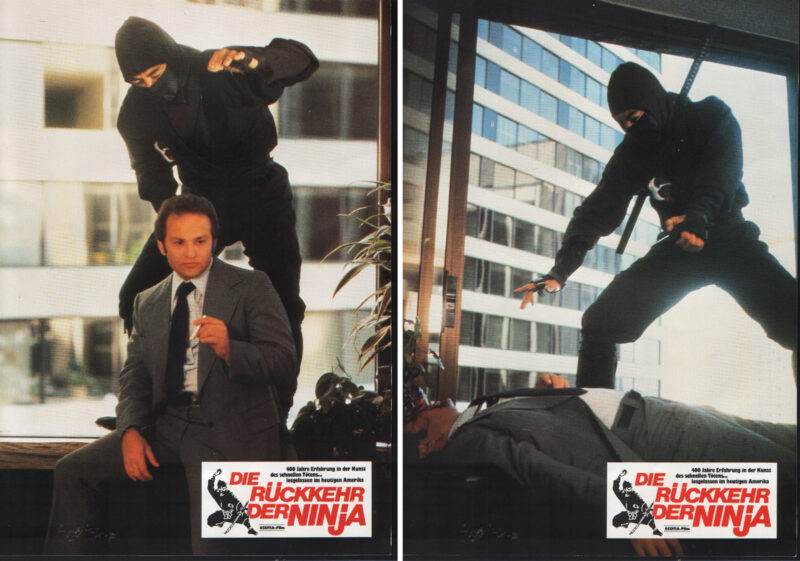
(Sometimes foreign ad campaigns featured images from cut scenes. These German lobby cards feature the unseen entry of Cho Osaki into the mob-infested skyscraper, wherein the shuko climbing claws served double duty as a melee weapon.)
But Kosugi learned his lessons on ROTN too. The Firstenberg and Cannon side of things taught him a pure martial arts film would only have limited niche appeal and be forever pigeon-holed after. For a true breakthrough success, Kosugi’s heroic ninja needed their James Bond and Dirty Harry elements, the films needed car chases and explosions.
The resulting film sees a martial arts guy having an absolute field day on set with open license. Kosugi also quietly joined a very small list of Japanese actors (alongside the likes of silent-era heartthrob Sessue Hayakawa and James Shigeta of Crimson Kimono fame) to actually outright LEAD an American film.
The Continuing Legacy
I had no intentions in 1983 of Revenge of the Ninja becoming my favorite ninja movie nor it cementing itself as the most important ninja movie ever made outside of Japan. That wasn’t going to be the case, simply because bigger and better was on the way, right? Right??? I mean, there were rumors in magazines about John Carpenter adapting Eric Van Lustbader’s novel The Ninja, Cannon already had a third Kosugi movie in the pipeline and a network TV show was on the horizon. This was THE NINJA BOOM after all, and if Spaghetti Westerns, Godfather/mafia knockoffs, Road Warrior-wannabees and Barbarian-exploitation had taught us anything, a shitload more Revenge of the Ninjas were on the way!
Except it didn’t happen.
A year later I’m sitting in a theater in Worcester, Massachusetts with my best friend Tim and some dudes from our local Karate school, and we’re watching Sho Kosugi take a back seat to an aerobics instructor and some imitation Exorcist fare coming a decade too late for that trend. Kosugi is never even hooded (we didn’t have the context at the time to understand the coolness of the tsuba eyepatch, a nod to Jubei Yagyu portrayals in classic Japanese cinema) and in general we were sort of looking at the screen with our heads tilted like confused German Shepherds.
The new Cannon ninja film we had rushed to with mouths frothing was supposed to be MORE ROTN — more straight up hooded ninja vs. hooded ninja duels, more of Kosugi in control and front and center as the film’s hero.
We wanted Revenge of the Ninja II, what we got was Ninja III: The Domination…
In retrospect it was the first chink in the armor of the ninja craze, the first sign all was not so well at Camp Cannon/Kosugi, the first waning of confidence in our beautiful R-rated blood-soaked and boob-bouyed exploitation genre. I mean what was next, pizza-chomping cartoon animals with catchphrases?
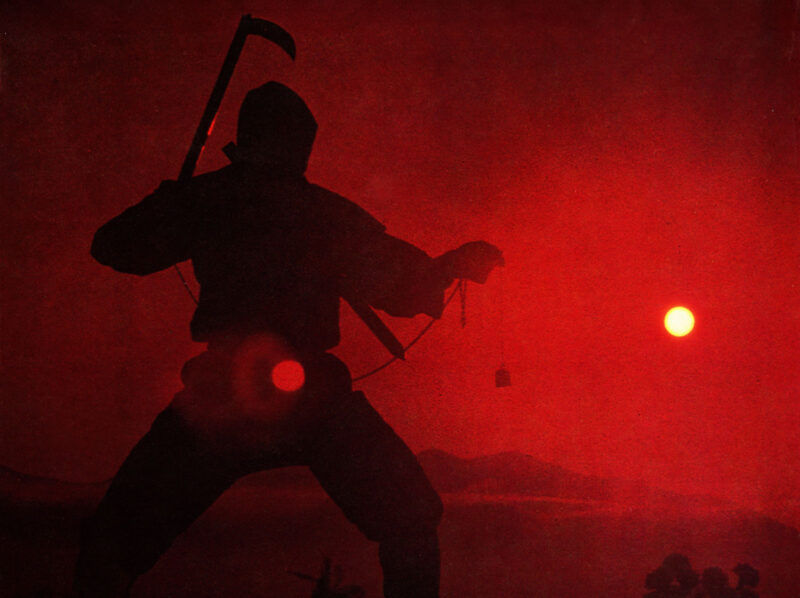
Alas, the closest we ever got to the perfection of Revenge of the Ninja again was Pray for Death, which depending on one’s taste and/or tolerance for THE HELMET and some rather unecessary trope-weary brutality to Donna Kae-Benz, has greatly variable milage. The Master being a network TV product was tame by its very nature, 9 Deaths of the Ninja was too much of a joke and Kosugi’s remaining catalog feels like he’s trying to completely escape the ninja thing but can’t and he clearly hates it. And yes, American Ninja was great, but it wasn’t Kosugi/ROTN great… that bar was set too high.
Since the craze daze, my fandom for Revenge of the Ninja has never diminished. It was always the go-to movie when I wanted to revisit the genre. Why mess around with anything else? I had a really good recording of the film off HBO, which had the uncut end scene with full blood spurt, something missing from several subsequent priced-to-own home video releases. The first time it hit DVD I was there, same with Blu-ray, and each and every time a new disc comes out I hope against hope some of the missing bits we’ve seen in trailers and various behind-the-scenes stills will surface. I’d kill to have more of the end fight, particularly the missing transitions from sword to knife for the final kill. There’s clearly a lot there we’ve never seen.
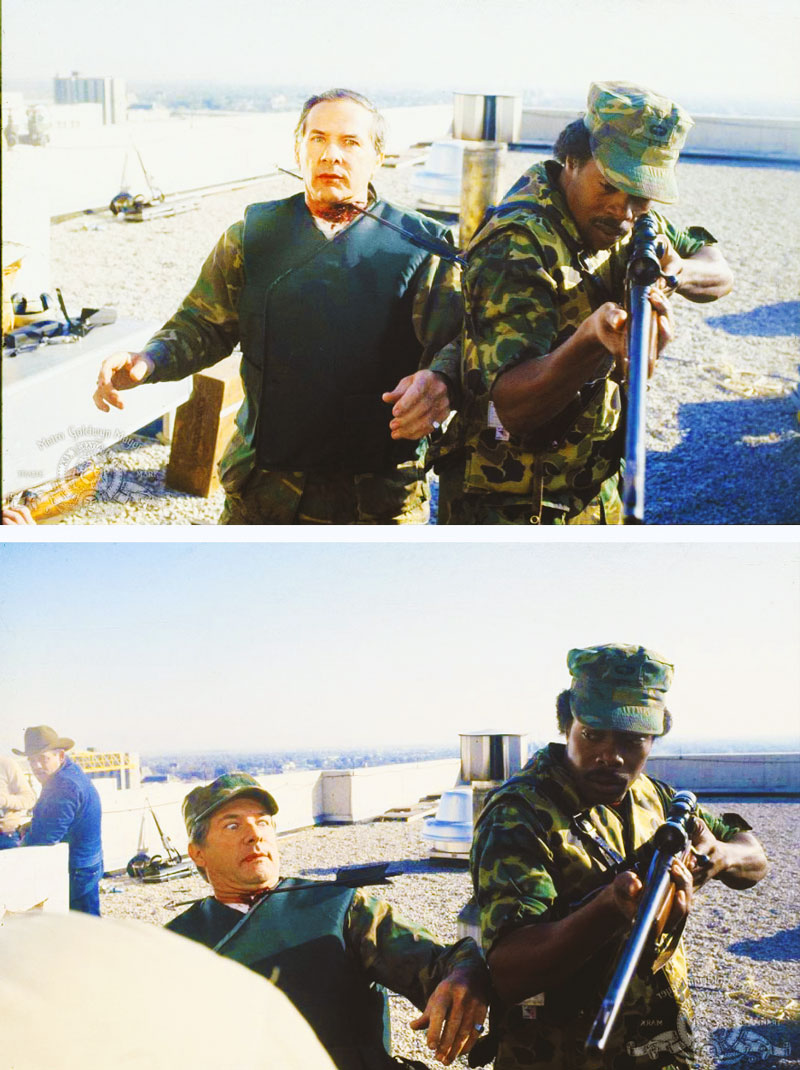
(Another cut scene, actually seen briefly in some versions of the trailer, show police/military snipers being taken out by one of the ascending ninja, I’m assuming Braden because of his casual attitude towards murdering law enforcement…)
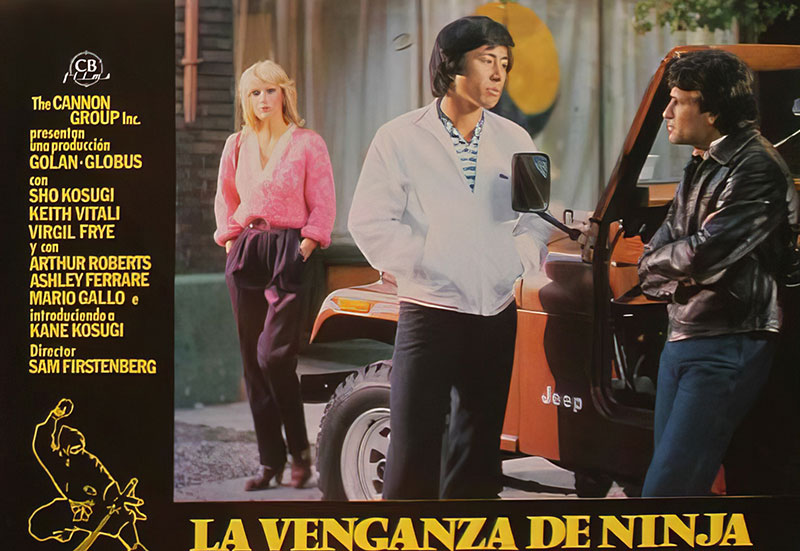
(This discarded conversation, seen only in Spanish-language lobby cards, probably took place in the first third to the middle of the film. And hey, Ashley Ferrare did NOT forget her pants!)
And I have never stopped buying ROTN-related merch, with a keen eye towards anything that uses the ubiquitous poster imagery in a nefarious way, like the below…
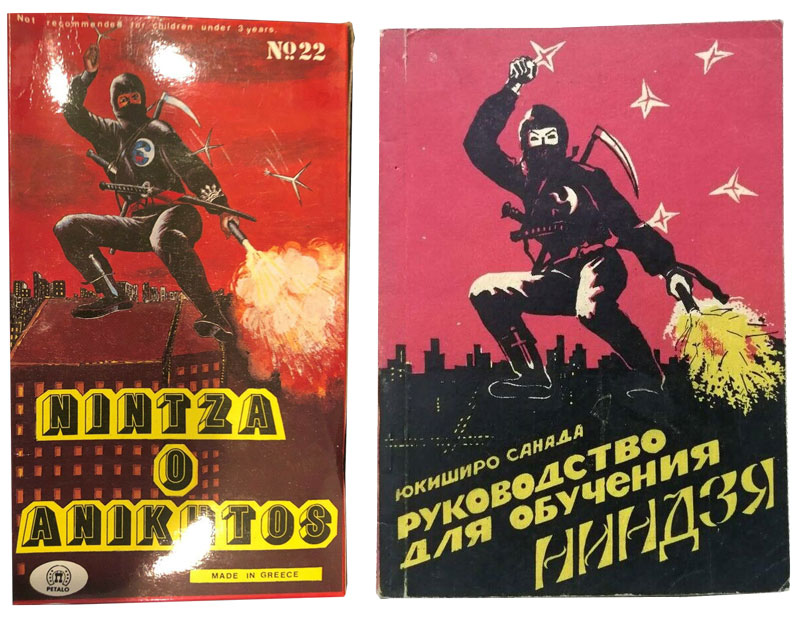
(The ROTN poster art ‘borrowed’ for other purposes — a box of Greek plastic ninja-men on left and a Russian-language martial arts manual from 1992 at right.)
Etsy and eBay are motherlodes of maker-produced love letters to ROTN. It’s no secret I’m a big toy collector and customizer myself, so I’m an absolute sucker for this sort of goodness…
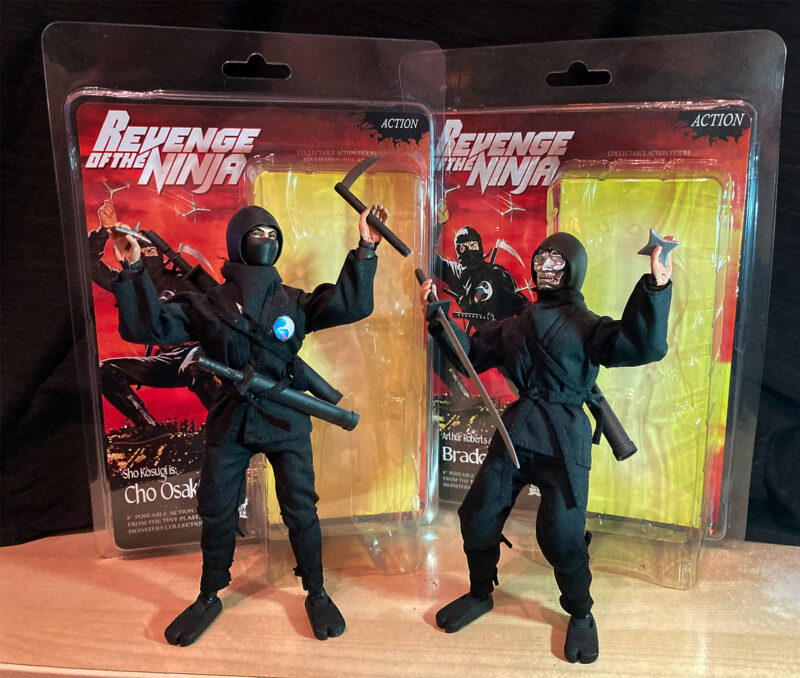
(Never having been properly licensed back in the day, action figure customizers have generated all sorts of different scale figures of Osaki and Braden in modern times. The 3.75″ GI Joe lines are more typical platforms for customs, but these 8″ figures built on the classic Mego style body from the 1970s are big and beautiful! Solo creator Tiny Plastic Men puts a few of these up every few months alongside all sorts of other genre gems.)
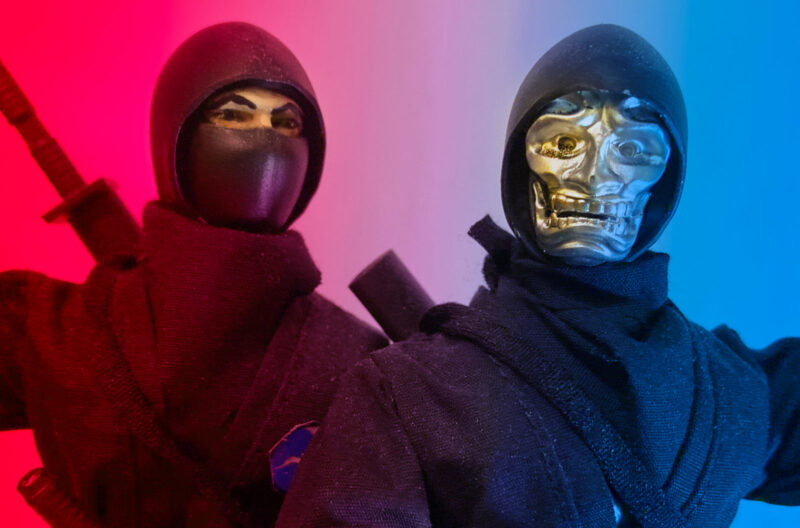
Storm Shadow? Ninja Viper? Bullshit, here’s a real Shinobi-Joe! Great custom card and card-back art can really drive home a good fan-figure:
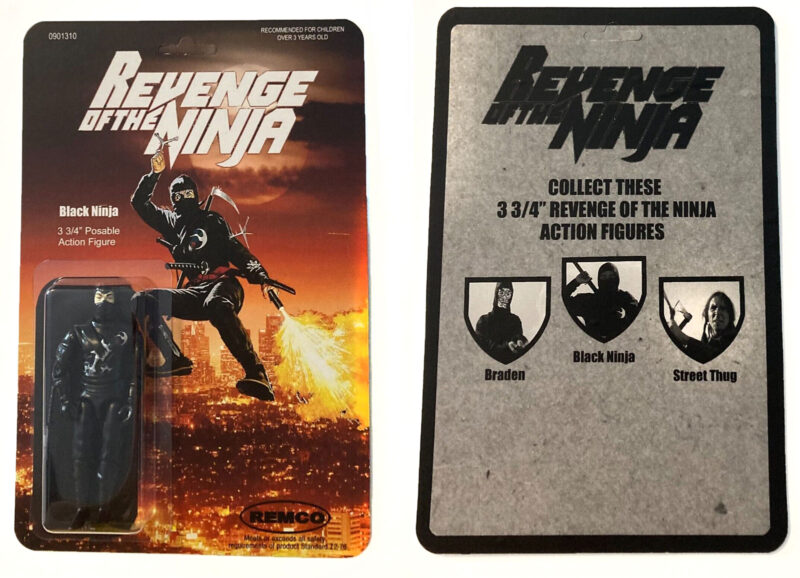
(From eBay seller Old Colony Hobbies aka popsfartberger)
And you can wear your love of ROTN on your sleeve, chest, book-bag, laptop lid or anywhere else with goods like these:
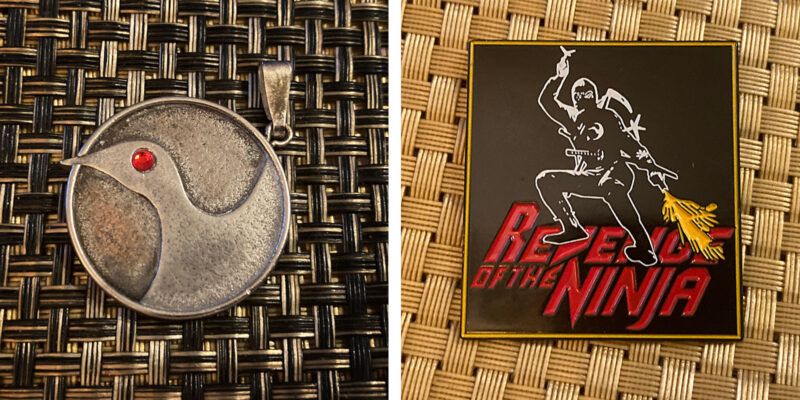
(Metal Osaki clan pendant made by Jason Blakely – selling on both Etsy and ShapeWays, and at right a massive cloissone pin by Shawn Wayne Lewis.)
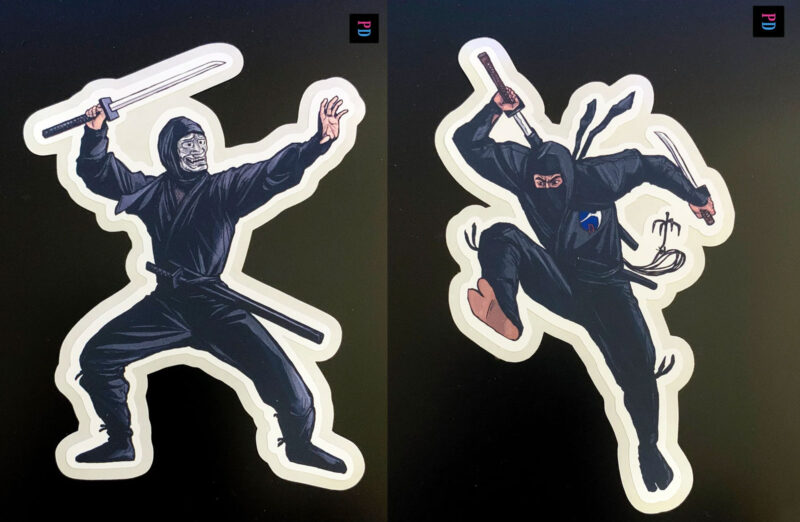
(Original art in t-shirt and sticker form from Preserved Dragons. They’ve also got images from The Octagon, Ninja III, Shogun Assassin, Enter the Dragon, Big Trouble in Little China, and more…)
The 2000s saw something I never anticipated — Ninja III: The Domination becoming a retro sensation among new young Cannon Films enthusiasts. Sans the context of not wanting a genre departure film so early in the rise of the genre, like I felt, that daffy third film has a massive following now. And I get it, it’s a genuine psychotronic experience and fertile ground for irony-inspired fandom. What I do resent is too often Revenge is all but forgotten — while N3 has two extras-loaded blu releases from competing labels, ROTN‘s no-frills discs hardly made a dent in the world. That apathy and/or lack-of-awareness for what should be considered the apex of the genre is changing a bit lately, and is long overdue. I’m hoping all the 40th Anniversary attention ROTN has gotten this fall will trigger some new love…
In 2017 I was hired to do a poster for a CD signing, but not just any signing — it was the debut of the ROTN soundtrack CD, the first release of Rob Walsh‘s iconic material since the original vinyl LP back in the day. Chuckling inside at where life can take you sometimes, there I am at a paid gig, blessed enough to shake the hands of Sam Firstenberg and go-to stuntman Steve Lambert. It was a long, strange trip coming first circle, with Revenge of the Ninja as my co-pilot…
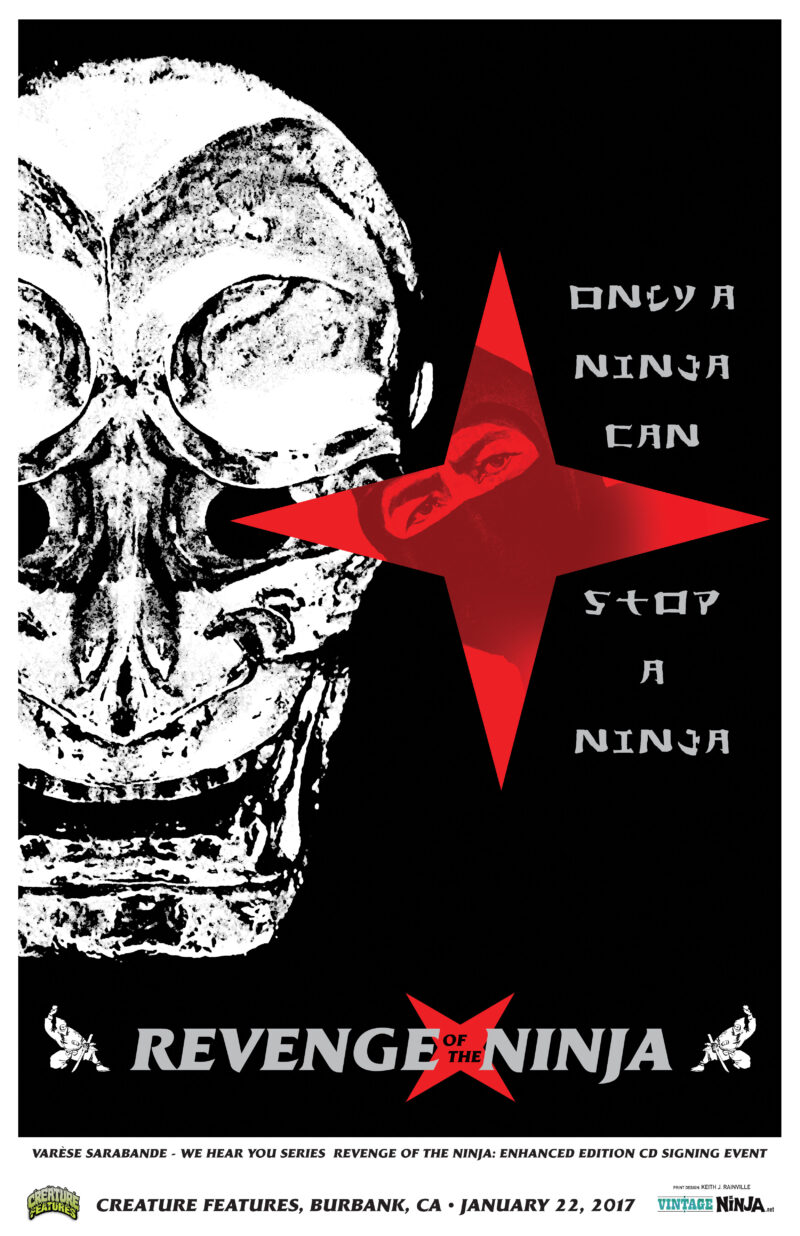
So yeah, as I stated in this article’s title, without that lighting bolt, without those endless repeated watchings of ROTN, I might never have become the disciple of the 80’s ninja craze I was. I might have tossed all those old issues of Black Belt and that sea-chest of cheap mail order weapons when I moved out of the folks’ house. And more than likely in the mid-2000s I don’t even bother starting my Nin-stalgia blog and this site never comes into existence and ALL OF OUR DAMN LIVES ARE EVEN MORE POINTLESS THAN THEY ALREADY ARE!
Genuinely, the only reason any of us are even HERE is Revenge of the Ninja, and on its 40th Anniversary I’d just like to thank Misters Kosugi, Firstenberg, Golan, Globus, Silke, Walsh and with a tear in the eye, bless you Steven Lambert, I truly wish you were still here with us to celebrate all this.
KR — September 2023
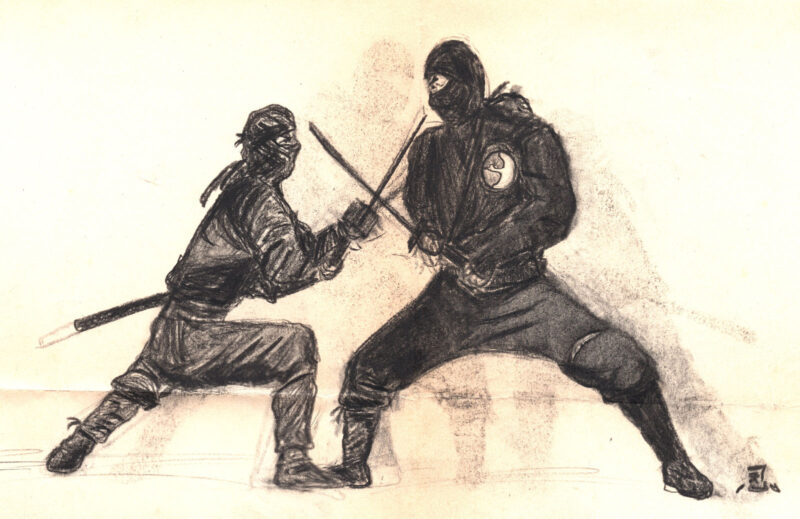
(My inept attempt at some charcoal pencil ninja art, circa 1984, modeled on the famous rooftop still.)
Essential Viewing
I cannot recommend enough the superb series of documentary videos coming from Retrofiend Radio!
